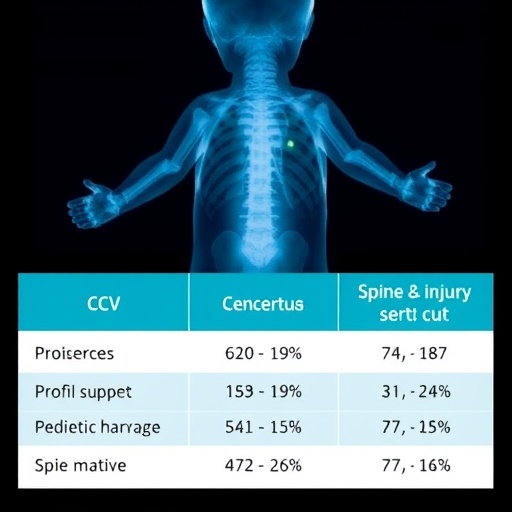Recent research led by a team of experts, including Alharbi, Chowdhury, and Albargi, has unveiled critical insights into the realm of traumatic spine injuries among pediatric and adolescent patients. This registry-based study addresses an urgent need to understand the specific requirements of young individuals suffering from such devastating injuries, emphasizing the need for proper Intensive Care Unit (ICU) management. As spine injuries in children can lead to long-lasting implications, this study aims to explore the clinical outcomes of these young patients and the prevailing conditions in which they are treated.
The prevalence of spinal injury among children and adolescents is alarmingly growing, necessitating immediate attention from both the medical community and society at large. This research highlights the risk factors, clinical presentations, and demographic characteristics that largely determine the outcomes of spinal trauma in younger populations. With advancements in technology and increased access to data, it is now feasible to conduct a comprehensive study utilizing registry data, thus elevating the importance of data-driven approaches in medical research.
In analyzing the data retrieved from hospitals across a wide geographical area, the study sheds light on various issues surrounding ICU admissions for pediatric spine injury victims. Researchers conducted a systematic assessment of the clinical needs of these patients, ensuring critical details regarding their condition, treatment regime, and recovery trajectory were recorded comprehensively. This systematic approach fills a significant gap in existing literature, where pediatric spine injuries are often overshadowed by adult trauma cases.
Notably, the findings reveal that the mechanisms of injury vary with demographics. For instance, boys are more frequently involved in high-impact sports, leading to traumatic injuries, whereas girls tend to be injured in accidents, portraying a critical divergence in injury patterns based on gender. Furthermore, age plays a prominent role, with younger children being more prone to injuries related to fall accidents. These differences inform tailored preventative measures and response strategies aimed at minimizing such injuries across various age groups.
The registry data also spans a considerable patient population, which elevates the significance of the study. With thousands of cases assessed, the research reflects a diverse array of experiences and outcomes, making the insights broadly applicable. Central trends emerge surrounding treatment efficiencies, lengths of hospital stay, and the types of surgical interventions employed.
An essential aspect of the study focuses on the ICU needs for these young patients. The study highlights that a significant proportion of pediatric spinal injury cases require substantial ICU resources. Insights gained from the study expose the correlation between injury severity and the length of ICU stay, underscoring the need for extensive resources when treating critically injured children. The implications of these findings are broad and call for hospitals to reevaluate their trauma protocols and resource allocation to address these specific needs adequately.
Additionally, the research thoroughly examines the clinical outcomes of pediatric patients with traumatic spine injuries. Insights into complications, recovery timelines, and long-term consequences have been thoroughly documented. Unfortunately, many children face not only immediate but also prolonged difficulties, including chronic pain and diminished mobility. The findings reinforce the importance of implementing supportive care plans post-discharge to facilitate better long-term rehabilitation outcomes.
Furthermore, the study brings to light the significance of interdisciplinary collaboration in the management of pediatric spine injuries. A collective approach involving emergency care physicians, orthopedic specialists, and rehabilitation teams can lead to improved outcomes and shared strategies for effective recovery. The research makes a compelling case for integrating various medical specialties to ensure that all facets of a child’s recovery are meticulously attended to.
Taking into account ethical considerations, the study was conducted with robust safeguards to protect the rights and confidentiality of the participants. This emphasis on ethical research practices reinforces the integrity of the data collected and maintains public trust. As pediatric spine injury cases often require sensitive handling, including family counseling and long-term care strategies, it is essential that ethical considerations guide all facets of treatment.
In conclusion, the findings presented by Alharbi and colleagues represent a valuable addition to the understanding of traumatic spine injuries in pediatric and adolescent populations. Through rigorous data acquisition and analysis, this study paves the way for future research that can further explore the nuances of injury patterns and treatment outcomes. It also sets the stage for health policymakers to bolster resources in pediatric care, ensuring that critically injured children receive the necessary attention and support throughout their recovery journey.
The implications of this study are numerous and far-reaching. As society continues to navigate the complexities of pediatric health, insights gathered from this research contribute to a broader narrative regarding injury prevention, treatment efficiencies, and long-term recovery prospects for young patients. This type of investigative work reinforces the importance of continuous research and innovation in pediatric healthcare, ensuring that all children are afforded the best possible care in the event of traumatic injuries.
Collectively, this study initiates a conversation around the vital role of registry-based research in illuminating gaps within pediatric trauma care. Emphasizing the need for ongoing data collection, the findings advocate for enhanced collaborative efforts among medical professionals, researchers, and public health officials, ultimately working toward a future where such traumatic injuries can be effectively minimized.
Subject of Research: Traumatic spine injuries in pediatric and adolescent patients
Article Title: Traumatic spine injuries in paediatric and adolescent patients: a registry-based study of ICU needs and clinical outcomes
Article References:
Alharbi, R.J., Chowdhury, S., Albargi, H. et al. Traumatic spine injuries in paediatric and adolescent patients: a registry-based study of ICU needs and clinical outcomes.
BMC Pediatr 25, 815 (2025). https://doi.org/10.1186/s12887-025-06102-9
Image Credits: AI Generated
DOI: 10.1186/s12887-025-06102-9
Keywords: Pediatric spine injuries, ICU needs, clinical outcomes, trauma, registry-based study




